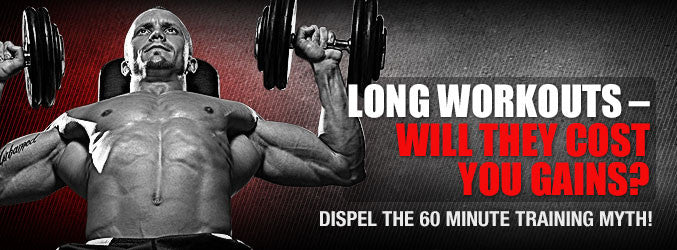
Bodybuilding is filled with legends. Arnold. Reg Park. Bill Pearl. Lee haney. Ronnie Coleman. Phil Heath. Legendary men with physiques which eclipsed every other iron ager in their generation. And then there are the other kind of legends in bodybuilding – the tales upon which the iron sport was built. Many training, nutritional & supplementation ideologies have stood for decades, simply because those following them read it as a youth in the Weider publications, and accepted it as gospel.
It’s long been believed in bodybuilding circles that training with weights for a period longer than an hour is forbidden. Many have written that doing so – training to minute #61 and beyond – will lead to a catabolic situation, as the hormone cortisol floods your body. Cortisol, the hormone responsible for eroding muscle and preserving body fat, is the bodybuilder’s worst enemy, after all.
Secreted in the body by your adrenal glands, cortisol helps the body to deal with stress. Its protein breakdown and subsequent protein synthesis are parts of the normal training process. You train, your body releases cortisol. And for many years, the magic “cutoff” time for cortisol damage has been 60 minutes. Let’s look at a few theories, ideas and recent discoveries which seem to dispel the 60 minute training myth!
New research
Emerging studies have shown that cortisol actually delivers some benefits in building and strengthening Type II muscle fibers. Cortisol release goes hand in hand with heavy weight training – and so do new muscle gains. Cortisol is a stress hormone which affects the body in many ways. However, studies are showing its presence when forming hypertrophy doesn’t have a negative effect as long believed. The opposite may even be true!
Slow it down
Cortisol is an extremely slow-acting hormone. Some hormones, such as insulin, will bind to the receptors in your body almost immediately. The response and change they deliver is seen very quickly. Cortisol’s transcription factor is a very slow process. Athletes who are quick to deliver the recover factors in an adequate manner may offset most of the potential effects of cortisol release. Quickly consuming a protein shake with a banana or other sugar after your workout can give your body a chance to shuttle amino acids to your torn muscle fibers quickly, often before the negative effects of cortisol kick in. And in the hours following a workout, you can make a great difference as well. Do you leave the gym and hit the club, spending the next 3 hours dancing, enchanting the fairer sex with your flexing at the bar, and doing shots of whatever flavor Fireball you desire? Or do you head home, binge watch some Netflix while massaging your sore muscles as your steak and potatoes cook?

Going heavy?
Very often, athletes choose to train extremely heavy, going for One Rep Max (1RM) training sessions instead of the traditional 8 to 12 repetitions per set. These kinds of training sessions can lead to great gains, and are a very solid tool for diagnosing current strength levels & determining how much weight should be used in upcoming workouts. However, they can wreak havoc upon the central nervous system of the body, leaving athletes with extremely high cortisol levels almost immediately after training. The body isn’t usually subjected to such intense training, and the result is great growth – and soreness too. Comparing the cortisol levels of a 45 minute “one rep max” workout with a 75 minute “moderate weight” workout, we can see the minutes fly out the window, and the intensity levels due to amount of weight used as a much more important factor in cortisol level effect evaluation.

Volume matters
Some lifters will knock out 40 sets in an hour, using a variety of superset, compound sets, down-the-racks, and other systems of lifting. Others will knock out a set, wait 3 minutes, and repeat, barely fitting 15 sets into an hour. The amount of cortisol released by the body in those two training sessions is going to be very different. Training volume, and the amount of rest between sets, can have a great effect upon stress hormone releases by the body.
Everybody is different
Every human being is built with a different “constitution”, the ability to withstand external and internal demands. Some can drink a bottle of whiskey and then chop down trees, while others sip wine and get sleepy. Some can train for hours without tiring, and others need much more recovery time. Cortisol level release is different in every athlete, so any level before or after 60 minutes could vary greatly. Additionally, we all have different levels of endurance and stamina. A brutal 60 minute workout for some is “just getting started” for more experienced athletes with world class genetics. You are built differently from everyone else in the gym – what you were born with and what you have built. These things heavily influence cortisol release rates and levels, which affect muscle maintenance differently among athletes.
Don’t believe everything you hear, and only half of what you see. Many longtime bodybuilding beliefs lasted for decades because there was nobody to challenge them. These days, scientific research on a global scale has resulted in many longtime dogma being tested, and refuted, resulting in a new realm of muscle knowledge for this next generation of lifters to analyze before un-learning many falsehoods in which they were indoctrinated as a youth. Long workouts don’t hurt gains – they can be one of your greatest assets in breaking plateaus and reaching new personal bests in terms of muscle mass, size and strength. Good luck!



